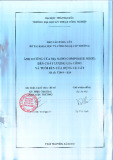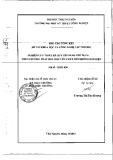
Hindawi Publishing Corporation
Journal of Inequalities and Applications
Volume 2011, Article ID 914270, 13 pages
doi:10.1155/2011/914270
Research Article
Stochastic Delay Lotka-Volterra Model
Lian Baosheng,1Hu Shigeng,2and Fen Yang1
1College of Science, Wuhan University of Science and Technology, Wuhan, Hubei 430065, China
2Department of Mathematics, Huazhong University of Science and Technology, Wuhan,
Hubei 430074, China
Correspondence should be addressed to Lian Baosheng, lianbs@163.com
Received 15 October 2010; Accepted 20 January 2011
Academic Editor: Alexander I. Domoshnitsky
Copyright q2011 Lian Baosheng et al. This is an open access article distributed under the Creative
Commons Attribution License, which permits unrestricted use, distribution, and reproduction in
any medium, provided the original work is properly cited.
This paper examines the asymptotic behaviour of the stochastic extension of a fundamentally
important population process, namely the delay Lotka-Volterra model. The stochastic version
of this process appears to have some intriguing properties such as pathwise estimation and
asymptotic moment estimation. Indeed, their solutions will be stochastically ultimately bounded.
1. Introduction
As is well known, Lotka-Volterra Model is nonlinear and tractable models of predator-prey
system. The predator-prey system is also studied in many papers. In the last few years, Mao
et al. change the deterministic model in this field into the stochastic delay model. and give it
more important properties 1–8.
Fluctuations play an important role for the self-organization of nonlinear systems;
we will study their influence on a simple nonlinear model of interacting populations, that
is, the Lotka-Volterra model. A simple analysis shows the result that the system allows
extreme behaviour, leading to the extinction of both of their species or to the extinction of
the predator and explosion of the prey. For example, in Mao et al. 1–8, we can see that once
the population dynamics are corporate into the deterministic subclasses of the delay Lotka-
Voterra model, the stochastic model will bear more attractive properties: the solutions will be
be stochastically ultimately bounded, and their pathwise estimation and asymptotic moment
estimation will be well done.
The most simple stochastic model is given in the form of a stochastic delay differential
equation also called a diffusion process; we call it a delay Lotka-Volterra model with
diffusion. The model will be
dxtdiagxtbAxtdt Bytdt Gdwt,1.1

2 Journal of Inequalities and Applications
where ytxt−τ,xtx1t,...,x
dtTwhere x1t,...,x
dtTdenotes the transpose
ofavectorormatrixx1t,...,x
dt,bb1,b
2,...,b
dT,Aaij ∈Rd×m,Bbij ∈Rd×m,
Gγij ∈Rd×mand wtis the m-dimensional Brownian motion, diag xt is the diag
matrix.
This model of the stochastic delay Lotka-Volterra is different from Mao et al. 3–
10, which paid more attention to the mathematical properties of the model than the real
background of the model. However, our model has the following three characteristics. First,
it is another stochastic delay subclass of the Lotka-Volterra model which is different from
Mao et al. Then we can obtain more comprehensive properties in Theorem 2.1.Second,in
this field no paper gives more attention to it so far, especially for the stochastic delay model
which is the focus in our model. Third, this model has many real applications, for example,
in economic growth model it is different from the old delay Lotka-Volterra model which only
palys a role in predator-prey system, for example, the stochastic R&D model 9,10is the
best application of this model. We hope our model can have new applications of the Lotka-
Volterra model. Throughout this paper, we impose the condition
−aii >A
i
j/
i
a
ij ,1≤i≤d,1.2
where a
ij aij if aij >0.
Of course, it is important for us to point that the condition 1.2may be not real in
predator-prey interactions, but in the stochastic R&D model in economic growth model, it
has a special meaning
−Kθmax
iaii Ai−θθA1θ
i
1θ1θ|aii|θ
i
θθA1θ
i
1θ1θ|aii|θ<0.1.3
If θ1/2 or 1, the inequality 1.3can be deduced to
−K1/2max
iaii Ai−2A3/2
i
27|aii|
i
2A3/2
i
27|aii|<0,1.4
−K1max
iaii Ai−A2
i
4|aii|
i
A2
i
4|aii|<0.1.5
If condition 1.2is satisfied, then
lim
θ→∞
θθA1θ
i
1θ1θ|aii|θ0.1.6
Therefore, if θis big enough, condition 1.2implies condition 1.3.

Journal of Inequalities and Applications 3
It is obvious the conditions 1.3–1.5are dependent on the matrix A, independent
on G.
Condition 1.4will be used in a further topic in the paper; the condition 1.4is
complicated, we can find many matrixes Athat have a property like this. For example,
Adiaga11,a
22,...a
dd
aii <0for1≤i≤d1.7
satisfy the condition 1.4.Furthermore,ifi/
j, aij ≤0, or aij are proper small enough positive
numbers, condition 1.4holds too. Particularly, if d2, the condition can be induced into
a11 a
12 <−2a
213/2
27a22
,a
22 a
12 <−2a
123/2
27a11
1.8
It is clear that the upper inequalities are the key conditions in the stochastic R&D model in
economic growth model.
Let
Iθx
ij
aij xθ
ixj.1.9
The homogeneous function Iθxof degree 1 θhas the following key property.
Lemma 1.1. Suppose the matrix Asatisfies condition 1.2.Let
Sx∈Rd
:x∞1;1.10
then
sup
x∈S
Iθx≤−Kθ,θ>0,1.11
where Kθis given in condition 1.3.
Proof. Fix x∈S,so0<x
j≤x∞1. We will show Iθx≤−Kθ.Wehave
Iθx≤
i
aiix1θ
i
i
j/
i
a
ij xθ
ixj
≤
iaiix1θ
iAixθ
i
i
ϕixi
1.12

4 Journal of Inequalities and Applications
with Aisatisfying condition 1.2,whereϕixiaiix1θ
iAixθ
i.Since,fromcondition1.2,
ϕi00, ϕi1aii Ai<0, and
ϕ′
it0⇒tt0−θAi
1θaii
θAi
1θ|aii|∈0,1,1.13
then
max
0≤t≤1ϕitϕitoθθA1θ
i
1θ1θ|aii|θMi.1≤i≤d.1.14
Since x∈S,wehave0<x
i≤1,1≤i≤d,x∈S, and there exits at least xi1, such that
ϕixi≤Mi,1≤i≤dand at least ϕixiϕi1aii Aifor some i.Thus
ϕixi≤max
i⎛
⎝aii Ai
j/
i
Mj⎞
⎠
max
iaii Ai−Mi
i
Mi.
1.15
Now, from condition 1.3, the right hand of the upper equation is just −Kθ,soIθx≤−Kθ;
Lemma 1.1 is proved.
We use the ordinary result of the polynomial functions.
Lemma 1.2. Let fi1≤i≤nbe a homogeneous function of degree θi,θ>θ
i≥0,anda>0;then
the function as follows has an upper bound for some constant K.
Fx
n
i1
fi−a
d
i1
xθ
i≤K.1.16
2. Positive and Global Solutions
Let Ω,F,{Ft}t≥0,Pbe a complete probability space with filtration {Ft}t≥0satisfying the usual
conditions, that is, it is increasing and right continuous while F0contains all P-null sets 8.
Moreover, let wtbe an m-dimensional Brownian motion defined on the filtered space and
Rd
{x∈Rd
:xi>0forall1 ≤i≤d}. Finally, denote the trace norm of a matrix A
by |A|traceATAwhere ATdenotes the transpose of a vector or matrix Aand its
operator norm by Asup{|Ax|:|x|1}.Moreover,letτ>0 and denote by C−τ, 0;Rd
the family of continuous functions from −τ, 0to Rd
.
The coefficients of 1.1do not satisfy the linear growth condition, though they are
locally Lipschitz continuous, so the solution of 1.1may explode at a finite time.
let us emphasize the important feature of this theorem. It is well known that a
deterministic equation may explode to infinity at a finite time for some system parameters
b∈Rdand A∈Rd×m. However, the explosion will no longer happen as long as conditions

Journal of Inequalities and Applications 5
1.2and 1.3hold. In other words, this result reveals the important property that conditions
1.2and 1.3suppress the explosion for the equation. The following theorem shows that
this solution is positive and global.
Theorem 2.1. Let us assume that K1/2satisfy
3K1/2>d
βi2β′
i,β
i
j
b
ij ,β
′
j
i
b
ij .2.1
Then for any given initial data {xt:−τ≤t≤0}∈C−τ, 0,R
d
, there exists a unique global
solution xxtto 1.1on t≥−τ. Moreover, this solution remains in Rd
with probability 1,
namely, xt∈Rd
for all t≥−τalmost surely.
Proof. Since the coefficients of the equation are locally Lipschitz continuous, for any given
initial data {xt:−τ≤t≤0}∈C−τ, 0,R
d
, there is a unique maximal local solution xt
on t∈0,ρ,whereρis the explosion time 3–10. To show this solution is global, we need to
show that ρ∞a.s. Let k0be sufficiently large for
1
k0
<min
−τ≤t≤0|xt|≤max
−τ≤t≤0|xt|≤k0.2.2
For each integer k≥k0, define the stopping time
τkinft∈0,ρ
:xit/∈k−1,k
,for some i1,...,d
,2.3
where throughout this paper we set inf φ∞as usual φdenotes the empty set. Clearly, τk
is increasing as k→∞.Setτ∞limk→∞τk, whence τ∞≤ρa.s. If we can show that τ∞∞
a.s., then ρ∞a.s. and xt∈Rd
a.s. for all t≥−τ. In other words, to complete the proof all
we need to show is that τ∞∞a.s. Or for all t>0, we have Pτk≤T→0,k→∞.To
show this statement, let us define a C2-functions V:Rd
−Rby
utt−lnt,V
tu√xix∈Rd
.2.4
The nonnegativity of this function can be seen from
utt−lnt>0on t > 0.2.5


























